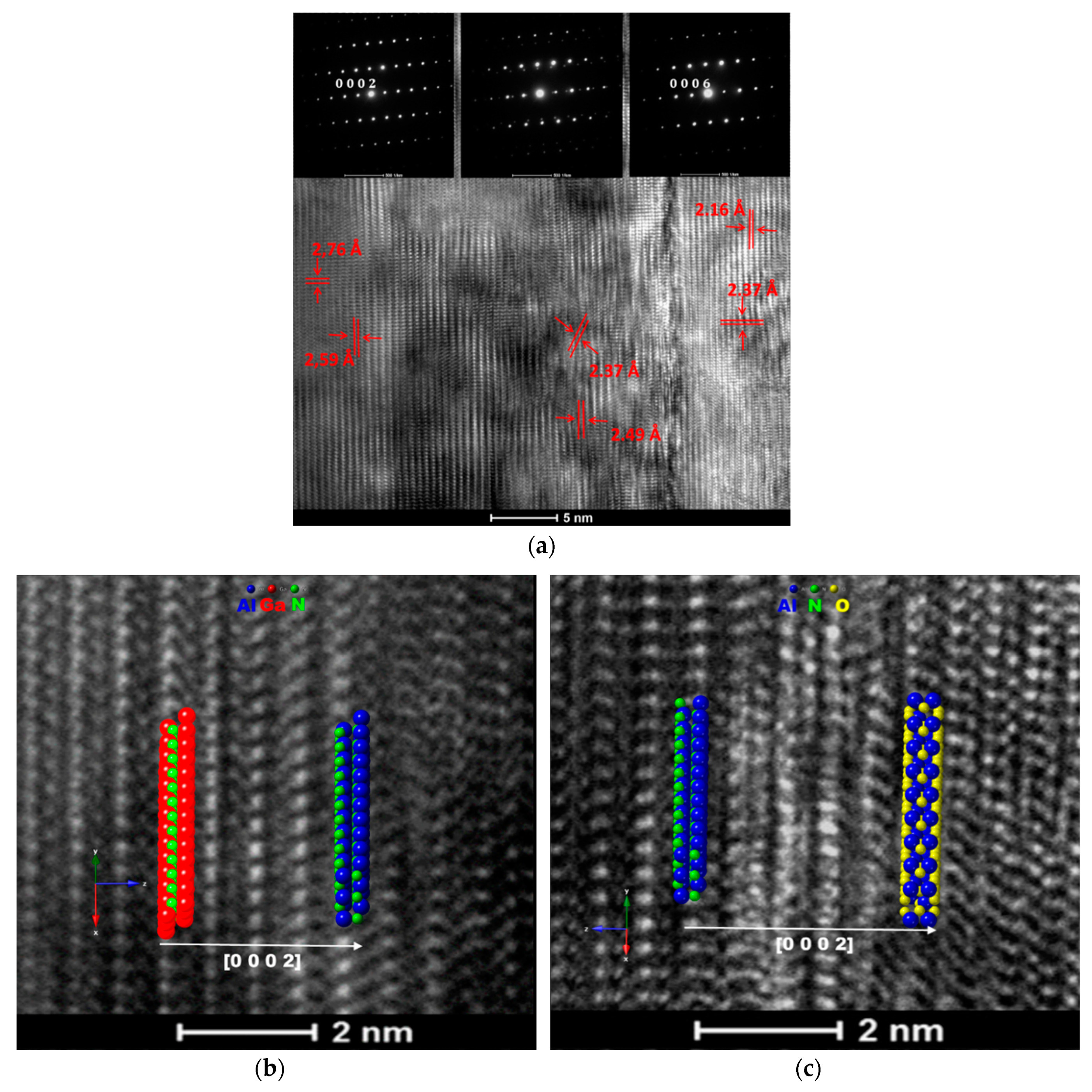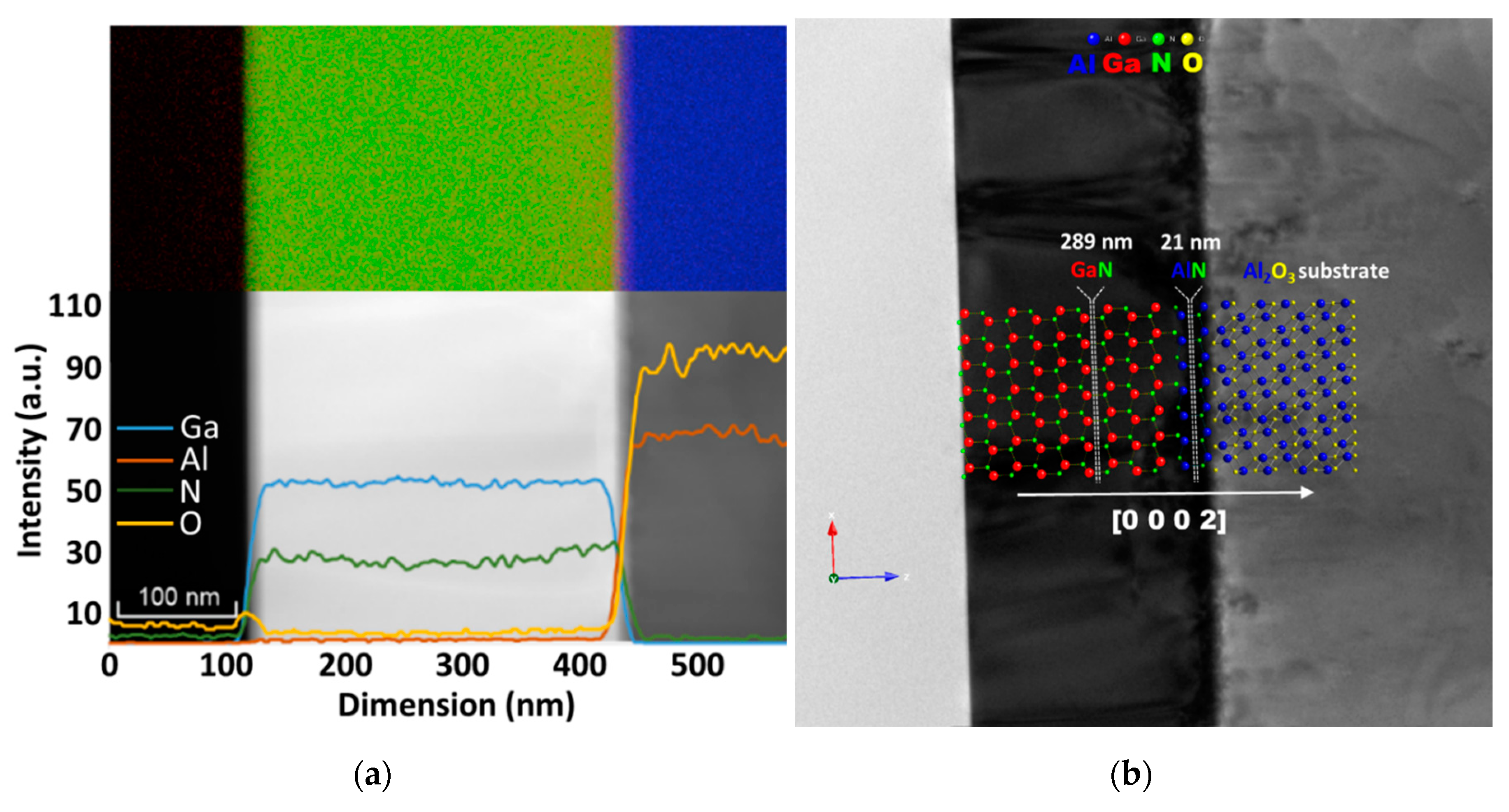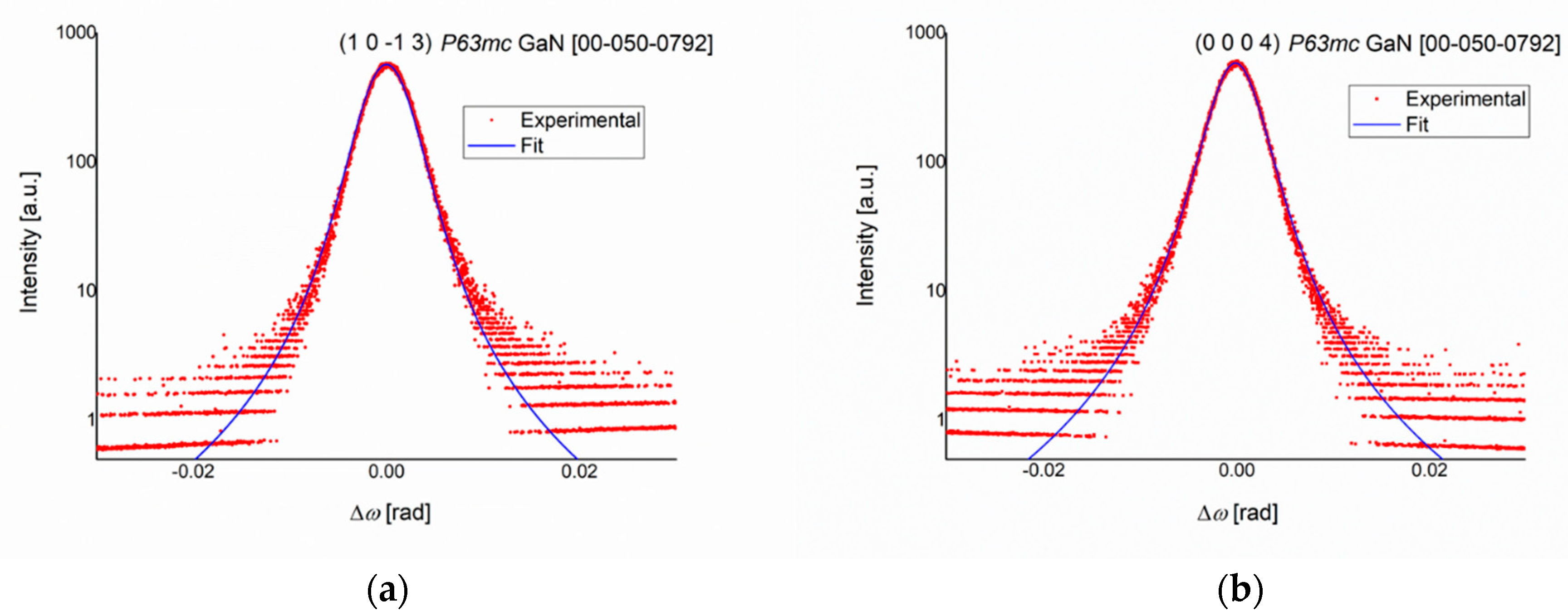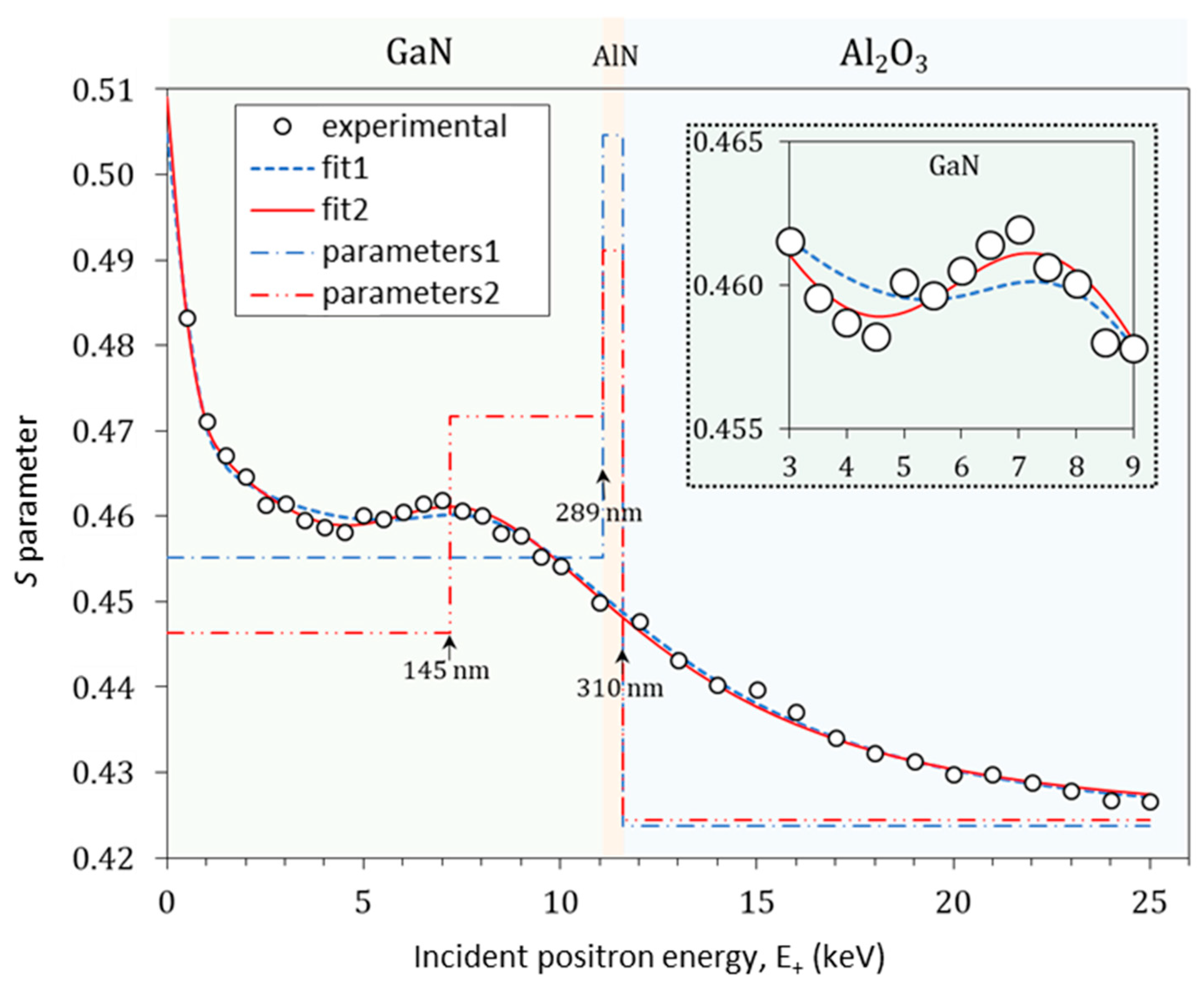Study of Edge and Screw Dislocation Density in GaN/Al2O3 Heterostructure
Abstract
1. Introduction
2. Materials and Methods
2.1. Materials
2.2. Microstructural Characterization
2.3. Defect Structure Determination
2.4. Doppler Broadening Spectroscopy
3. Results and Discussion
3.1. Microstructural Characterization
3.2. Positron Annihilation Data
4. Conclusions
Author Contributions
Funding
Acknowledgments
Conflicts of Interest
References
- Pearton, S.J.; Ren, F.; Zhang, A.P.; Dang, G.; Cao, X.A.; Lee, K.P.; Cho, H.; Gila, B.P.; Johnson, J.W.; Monier, C.; et al. GaN electronics for high power, high temperature applications. Mater. Sci. Eng. B 2001, 82, 227–231. [Google Scholar] [CrossRef]
- Pearton, S.J. GaN and Related Materials II; Gordon & Breach Science Publishers: Boca Raton, FL, USA, 2000. [Google Scholar]
- Yang, L.; Xu, X.; Wei, B. Study on n-type GaN based organic-inorganic hybrid light emitting heterojunction. J. Lumin. 2019, 206, 393–397. [Google Scholar] [CrossRef]
- Lin, Z.; Wang, H.; Lin, Y.; Yang, M.; Li, G.; Xu, B. A new structure of p-GaN/InGaN heterojunction to enhance hole injection for blue GaN-based LEDs. J. Phys. D 2016, 49, 285106. [Google Scholar] [CrossRef]
- Lidow, A.; de Rooij, M.; Strydom, J.; Reusch, D.; Glaser, J. GaN Transistors for Efficient Power Conversion; John Wiley & Sons: Hoboken, NJ, USA, 2019. [Google Scholar]
- Kukushkin, S.A.; Osipov, A.V.; Bessolov, V.N.; Medvedev, B.K.; Nevolin, V.K.; Tcarik, K.A. Substrates for epitaxy of Gallium Nitride: New materials and techniques. Rev. Adv. Mater. Sci. 2008, 17, 1–32. [Google Scholar]
- Sun, C.J.; Kung, P.; Saxler, A.; Ohsato, H.; Bigan, E.; Razeghi, M.; Gaskill, D.K. Thermal stability of GaN thin films grown on (0001) Al2O3, (0112) Al2O3 and (0001)Si 6H-SiC substrates. J. Appl. Phys. 1994, 76, 236–241. [Google Scholar] [CrossRef]
- Stach, E.A.; Kelsch, M.; Nelson, E.C.; Wong, W.S.; Sands, T.; Cheung, N.W. Structural and chemical characterization of free-standing GaN films separated from sapphire substrates by laser lift-off. Appl. Phys. Lett. 2000, 77, 1819–1821. [Google Scholar] [CrossRef]
- Jean, Y.C.; Mallon, P.E.; Schrader, D.M. Principles and Applications of Positron and Positronium Chemistry; World Scientific: Singapore, 2003. [Google Scholar]
- Selim, F.A.; Agarwal, S.; Liedke, M.O.; Butterling, M.; Wagner, A.; Hosemann, P.; Li, N.; Wang, Y.; Uberuaga, B.P. Depth Resolved Measurements of Atomic Scale Defects in Ion Irradiated Fe Alloys. Microsc. Microanal. 2019, 25, 1546–1547. [Google Scholar] [CrossRef]
- Tuomisto, F.; Makkonen, I. Defect identification in semiconductors with positron annihilation: Experiment and theory. Rev. Mod. Phys. 2013, 85, 1583–1631. [Google Scholar] [CrossRef]
- Krause-Rehberg, R.; Leipner, H.S. Positron Annihilation in Semiconductors—Defect Studies; Springer: Berlin, Germany, 1999. [Google Scholar]
- Pi, X.D.; Coleman, P.G.; Tseng, C.L.; Burrows, C.P.; Yavich, B.; Wang, W.N. Defects in GaN films studied by positron annihilation spectroscopy. J. Phys. Condens. Matter 2002, 14, L243–L248. [Google Scholar] [CrossRef]
- Peng, C.X.; Weng, H.M.; Zhu, C.F.; Ye, B.J.; Zhou, X.Y.; Han, R.D.; Fong, W.K.; Surya, C. Influence of GaN polarity and intermediate-temperature buffer layers on strain relaxation and defects. Physica B 2007, 391, 6–11. [Google Scholar] [CrossRef]
- Schafler, E.; Zehetbauer, M.; Ungàr, T. Measurement of screw and edge dislocation density by means of X-ray Bragg profile analysis. Mater. Sci. Eng. 2001, 319, 220–223. [Google Scholar] [CrossRef]
- Kelly, A.; Knowles, K.M. Crystallography and Crystal Defects, 2nd ed.; John Wiley & Sons, Inc.: Chichester, UK, 2012. [Google Scholar]
- Schneider, C.A.; Rasband, W.S.; Eliceiri, K.W. NIH Image to ImageJ: 25 years of image analysis. Nat. Methods 2012, 9, 671–675. [Google Scholar] [CrossRef] [PubMed]
- Palmer, D.C. CrystalMaker; CrystalMaker Software: Begbroke, UK, 2014. [Google Scholar]
- Kaganer, V.M.; Brandt, O.; Trampert, A.; Ploog, K.H. X-ray diffraction peak profiles from threading dislocations in GaN epitaxial films. Phys. Rev. B 2005, 72, 045423. [Google Scholar] [CrossRef]
- Van Veen, A.; Schut, H.; de Vries, J.; Hakvoort, R.A.; Ijpma, M.R. Analysis of positron profiling data by means of “VEPFIT”. AIP Conf. Proc. 1991, 218, 171–198. [Google Scholar]
- Van Veen, A.; Schut, H.; Clement, M.; de Nijs, J.M.M.; Kruseman, A.; Jpma, M.R.I. VEPFIT applied to depth profiling problems. Appl. Surf. Sci. 1995, 85, 216–224. [Google Scholar] [CrossRef]
- Yu, H.; Ozturk, M.K.; Ozcelik, S.; Ozbay, E. A study of semi-insulating GaN grown on AlN buffer/sapphire substrate by metalorganic chemical vapor deposition. J. Cryst. Growth 2006, 293, 273–277. [Google Scholar]
- Claudel, A.; Fellmann, V.; Gélard, I.; Coudurier, N.; Sauvage, D.; Balaji, M.; Blanquet, E.; Boichot, R.; Beutier, G.; Coindeau, S.; et al. Influence of the V/III ratio in the gas phase on thin epitaxial AlN layers grown on (0001) sapphire by high temperature hydride vapor phase epitaxy. Thin Solid Films 2014, 573, 140–147. [Google Scholar] [CrossRef]
- Miyagawa, R.; Yang, S.; Miyake, H.; Hiramatsu, K.; Kuwahara, T.; Mitsuhara, M.; Kuwano, N. Microstructure of AlN grown on a nucleation layer on a sapphire substrate. Appl. Phys. Express 2012, 5, 2. [Google Scholar] [CrossRef]
- Jiménez, J.J.; Mánuel, J.M.; Bartsch, H.; Breiling, J.; García, R.; Jacobs, H.O.; Müller, J.; Pezoldt, J.; Morales, F.M. Comprehensive (S)TEM characterization of polycrystalline GaN/AlN layers grown on LTCC substrates. Ceram. Int. 2019, 45, 9114–9125. [Google Scholar] [CrossRef]
- Li, Y.; Zhang, C.; Luo, X.; Liang, Y.; Wuu, D.S.; Tin, C.C.; Lu, X.; He, K.; Wan, L.; Feng, Z.C. Surface, structural and optical properties of AlN thin films grown on different face sapphire substrates by metalorganic chemical vapor deposition. Appl. Surf. Sci. 2018, 458, 972–977. [Google Scholar] [CrossRef]
- Jørgensen, L.V.; Schut, H. GaN-a new material for positron moderation. Appl. Surf. Sci. 2008, 255, 231–233. [Google Scholar] [CrossRef]
- Zubiaga, A.; García, J.A.; Plazaola, F.; Tuomisto, F.; Zúñiga-Pérez, J.; Muñoz-Sanjosé, V. Positron annihilation spectroscopy for the determination of thickness and defect profile in thin semiconductor layers. Phys. Rev. B 2007, 75, 205305. [Google Scholar] [CrossRef]
- Schultz, P.J.; Tandberg, E.; Lynn, K.G.; Nielsen, B. Defects and Impurities at the Si/Si (100) Interface Studied with Monoenergetic Positrons. Phys. Rev. Lett. 1988, 61, 187–191. [Google Scholar] [CrossRef] [PubMed]
- Uedono, A.; Malinverni, M.; Martin, D.; Okumura, H.; Ishibashi, S.; Grandjean, N. Vacancy-type defects in Mg-doped GaN grown by ammonia-based molecular beam epitaxy probed using a monoenergetic positron beam. J. Appl. Phys. 2016, 119, 245702. [Google Scholar] [CrossRef]
- Makkonen, I.; Snicker, A.; Puska, M.J.; Mäki, J.M.; Tuomisto, F. Positrons as interface-sensitive probes of polar semiconductor heterostructures. Phys. Rev. B 2010, 82, 2–5. [Google Scholar] [CrossRef]
- Bogusławski, P.; Rapcewicz, K.; Bernholc, J.J. Surface segregation and interface stability of AlN/GaN, GaN/InN, and AlN/InN {0001} epitaxial systems. Phys. Rev. B 2000, 61, 10820–10826. [Google Scholar] [CrossRef]
- Hu, Y.F.; Shan, Y.Y.; Beling, C.D.; Fung, S.; Xie, M.H.; Cheung, S.H.; Tu, J.; Brauer, G.; Anwand, W.; Tong, D.S.Y. GaN Thin Films on SiC Substrates Studied Using Variable Energy Positron Annihilation Spectroscopy. Mater. Sci. Forum 2001, 363, 478–480. [Google Scholar] [CrossRef]




| Plane | Le (nm) | Ls (nm) | ||
|---|---|---|---|---|
| (0 0 0 4) | - | 1.36 × 1010 | - | 229 |
| () | 6.13 × 1010 | - | 155 | - |
| Fit1 χ2 = 2.07 | Fit2 χ2 = 1.48 | ||||||
|---|---|---|---|---|---|---|---|
| Layer/Sublayer | Leff [nm] | S | d [nm] | Leff [nm] | S | d [nm] | |
| GaN | 1 | 63 (3) | 0.4552 (7) | 289 | 60 (3) | 0.446 (2) | 145 |
| 2 | 46 (9) | 0.472 (3) | 144 | ||||
| AlN | 24 (1) | 0.546 (3) | 21 | 43 (8) | 0.49 (2) | 21 | |
| Al2O3 | 80 | 0.4238 (3) | - | 80 | 0.4244 (3) | - | |
© 2019 by the authors. Licensee MDPI, Basel, Switzerland. This article is an open access article distributed under the terms and conditions of the Creative Commons Attribution (CC BY) license (http://creativecommons.org/licenses/by/4.0/).
Share and Cite
Ene, V.L.; Dinescu, D.; Zai, I.; Djourelov, N.; Vasile, B.S.; Serban, A.B.; Leca, V.; Andronescu, E. Study of Edge and Screw Dislocation Density in GaN/Al2O3 Heterostructure. Materials 2019, 12, 4205. https://doi.org/10.3390/ma12244205
Ene VL, Dinescu D, Zai I, Djourelov N, Vasile BS, Serban AB, Leca V, Andronescu E. Study of Edge and Screw Dislocation Density in GaN/Al2O3 Heterostructure. Materials. 2019; 12(24):4205. https://doi.org/10.3390/ma12244205
Chicago/Turabian StyleEne, Vladimir Lucian, Doru Dinescu, Iulia Zai, Nikolay Djourelov, Bogdan Stefan Vasile, Andreea Bianca Serban, Victor Leca, and Ecaterina Andronescu. 2019. "Study of Edge and Screw Dislocation Density in GaN/Al2O3 Heterostructure" Materials 12, no. 24: 4205. https://doi.org/10.3390/ma12244205
APA StyleEne, V. L., Dinescu, D., Zai, I., Djourelov, N., Vasile, B. S., Serban, A. B., Leca, V., & Andronescu, E. (2019). Study of Edge and Screw Dislocation Density in GaN/Al2O3 Heterostructure. Materials, 12(24), 4205. https://doi.org/10.3390/ma12244205







